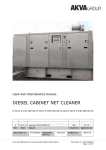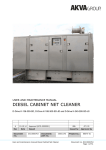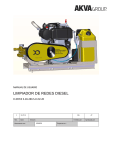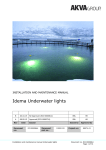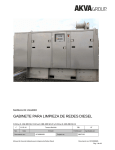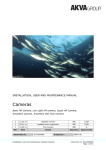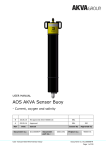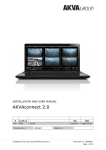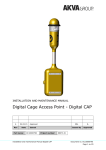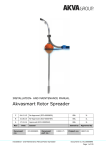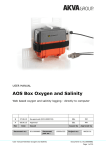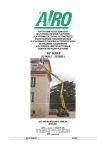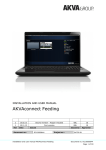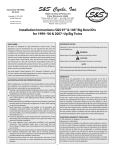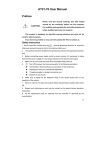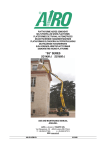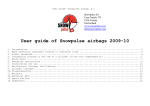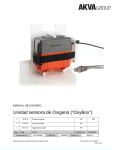Download UK User Manual Cabinet Diesel Net Cleaner
Transcript
USER AND MAINTENANCE MANUAL DIESEL CABINET NET CLEANER D-Drive K-136-300-SD, D-Drive K-188-300-SD-JD and D-Drive K-240-280-SD-JS A 14.01.15 Rev Date Document no.: Approved (ECO-0000615) Issued DC10000685 Document part no.: 10001269 User and Maintenance manual Diesel Cabinet Net Cleaner EBL AT / IS Issued by Approved by Project no.: 88075-01 Document no. DC10000685 Page 1 of 48 For a thorough introduction of Your AKVA product, we ask that all users read this entire manual. If questions occur, contact us! The information in this document is subject to change without notice and must not be construed as a commitment by AKVA group ASA. AKVA group ASA assumes no responsibility for any errors that may appear in this document. In no event shall AKVA group ASA be liable for incidental or consequential damages arising from use of this document or of the software and hardware described in this document. We reserve all rights in this document and in the information contained therein. Reproduction, use or disclosure to third parties without express authority is strictly forbidden. This document may also be read and downloaded from our website, see www.akvagroup.com/products/user-manuals © 2015 AKVA group ASA (NO) User and Maintenance manual Diesel Cabinet Net Cleaner Document no. DC10000685 Page 2 of 48 Table of contents 1 Safety ......................................................................................................5 1.1 Safety symbols .......................................................................................... 5 1.2 Receiving new equipment............................................................................. 6 1.3 Inspection before use .................................................................................. 7 1.4 General safety ........................................................................................... 7 1.5 Personnel safety ........................................................................................ 8 1.6 Equipment safety ....................................................................................... 9 2 Introduction ..........................................................................................11 2.1 Contact information .................................................................................. 13 3 Model description ..................................................................................14 4 Main components ...................................................................................15 4.1 Specifications .......................................................................................... 16 4.2 Specifications Net Cleaner Frames .............................................................. 16 5 Before use .............................................................................................17 5.1 Oil check ................................................................................................. 17 5.2 Coolant ................................................................................................... 20 5.3 Safety valve ............................................................................................ 20 5.4 Hoses ..................................................................................................... 21 5.5 Suction hose ........................................................................................... 21 5.6 Net Cleaning Frames ................................................................................ 21 6 Starting and stopping the machinery ..................................................... 22 7 Emergency stop and restart ...................................................................24 8 Control panel alarms .............................................................................25 9 Net Cleaner Frames ...............................................................................26 10 The mobile control unit ..........................................................................27 User and Maintenance manual Diesel Cabinet Net Cleaner Document no. DC10000685 Page 3 of 48 11 Cleaning and storage .............................................................................28 11.1 After use/before storage ........................................................................... 28 11.2 Inside cabinet cleaning ............................................................................. 29 11.3 Cleaning the Net Cleaner Frame ................................................................. 30 12 Maintenance ..........................................................................................31 12.1 Overview oil ............................................................................................ 31 12.2 Motor ..................................................................................................... 31 12.3 Motor filters ............................................................................................ 31 12.4 Coolant ................................................................................................... 33 12.5 Ventilating the diesel system ..................................................................... 33 12.6 The pump ............................................................................................... 34 12.7 Gear ...................................................................................................... 34 12.8 Feed pump .............................................................................................. 35 12.9 Sea water filter ........................................................................................ 35 12.10 Net cleaning frames ................................................................................. 35 12.11 Battery ................................................................................................... 36 13 Maintenance plans and forms ................................................................37 13.1 Daily maintenance ................................................................................... 39 13.2 Weekly maintenance ................................................................................ 40 13.3 First time maintenance ............................................................................. 41 13.4 Registration of further maintenance ............................................................ 41 Appendix A - Index ..........................................................................................43 Appendix B - Deviation form ............................................................................45 Appendix C - Notes User and Maintenance manual Diesel Cabinet Net Cleaner 46 Document no. DC10000685 Page 4 of 48 1 Safety Safety for the users of our equipment is top focus when AKVA group ASA develop new products and product manuals. We therefore strongly recommend that everyone that use the equipment, all that perform any type of repairs, service or other maintenance to the product, and all that work in areas where the product is installed read this entire manual and at least this safety chapter. This recommendation is based on both personnel safety as well as a desire to keep the products in order and avoid damages risked if the safety instructions are not followed. 1.1 Safety symbols The following safety symbols are used in this manual: Information Show caution, danger of damaging equipment and mild injuries to personnel Warning, may cause injures to personnel Dangerous situations may occur, danger of escaping 1.1.1 Other symbols used in this manual Go to or see page or chapter for further instructions or more information User and Maintenance manual Diesel Cabinet Net Cleaner Document no. DC10000685 Page 5 of 48 The high pressure system must not be operated, and no work may be performed on the system before the safety precautions described in this manual have been read and understood Site manager and farm manager are responsible for instructing all workers who are working on the site where the Net Cleaner is going to be used, are aware of this manual, and that everyone understands its content Safety information from this chapter must not be construed as a warranty by AKVA group ASA that the high pressure net cleaner will not cause injury or damage even if all safety instructions have been complied with 1.2 Receiving new equipment Make sure that all parts are delivered according to the service note. If the order is incomplete, or any defects are discovered, contact AKVA immediately. Contact information is found in chapter 2.1 in this manual. AKVA group ASA offers a 1 year warranty, covering production defects. This warranty is efficient after date of shipment to original customer. Misuse of the equipment due to neglecting instructions in this and other manuals connected to the equipment may invalidate this warranty. User and Maintenance manual Diesel Cabinet Net Cleaner Document no. DC10000685 Page 6 of 48 1.3 Inspection before use High pressure water represents massive forces, and it is therefore important that critical components are inspected and tested regularly. Safety valves are installed in all high pressure equipment in order to prevent the pressure inside the system from exceeding maximal pressure endured by the various components. The safety valve is set to open up for water flow in case the pressure exceeds predetermined level. Out of order valves can cause severe damage to the system, as well as endangering personnel safety and damaging equipment installed nearby. (ref. § 30) The safety valve is set to the maximal working pressure that the equipment manages to endure. Never change this pressure point to a higher pressure. (ref. § 14) All hoses used in this construction, must be able to endure the maximal working pressure of the equipment. Make sure that all hoses endure this pressure, by looking at the labelling on the hose outside. All hoses must be inspected for tears and other external damages. If the hose is damaged, it must be replaced or repaired before use. 1.4 General safety Show great caution when using high pressure equipment. The equipment generates a large amount of forces that may cause severe damage to both personnel and equipment if used incorrectly. Whilst using this high pressure net cleaner, the “Regulations about high pressure cleaning and more” (FOR 1992-02-13 nr 1263: Forskrift om høytrykksspyling m.m.), has to be complied. According to § 4 in these regulations, overstepping them is a legal offence. User and Maintenance manual Diesel Cabinet Net Cleaner Document no. DC10000685 Page 7 of 48 1.5 Personnel safety All personnel must be trained in how to operate the equipment and also be made aware of all of the dangers that may be consequences from improper use. (ref. § 6) Employer is responsible for composing instructions for their personnel, explaining which of the operations can cause danger towards the user. All personnel must know these instructions, and the employer has the responsibility of making sure that the personnel understands it. (ref. § 7) Employer is responsible for their employees using appropriate protective equipment whilst cleaning with high pressure, such as eye, hand and body protection. Always use anti slip boots whilst walking around the cage edge. When conditions require, employer must order all workers to use necessary safety equipment. (ref. § 9) A helping operator is mandatory when the person operating the cleaning equipment has reduced vision of the high pressure cabinet. The person operating the net cleaner frame must be able to communicate, preferably visually, with the person operating the cabinet. (ref. § 22) Fastening and sealing, of leaks in piping- or hose-fittings, can only be performed when the machinery is turned off and without any internal pressure. (ref. § 13) Employer is responsible for marking, limiting access to and properly securing the area where a high pressure net cleaner is being used. (ref. § 23) Reaction forces must be balanced when using manually controlled net cleaners. During the cleaning process, only one diver may stay in the water surrounding the high pressure net cleaner. An assistant employee responsible for controlling the pumping aggregate is necessary, so that the process can be shut down immediately in case of any emergency. (ref. § 26) User and Maintenance manual Diesel Cabinet Net Cleaner Document no. DC10000685 Page 8 of 48 Under aged personnel (under 18 years of age) must not operate the net cleaner on their own. (ref. Regulations about work performed by children and youth, § 9) 1.6 Equipment safety 1.6.1 Storage Do not store the equipment at high temperatures. It is advised that the equipment is rinsed off with a narrow beam of water directed away from people after storage, because of risk of Legionella contamination. Salt water may damage the equipment if left drying inside the system. The high pressure pump, and internal components surrounding this, such as suction pump, filters, safety valve, hoses or other salt water leading components are especially vulnerable towards salt water. When the salt water dries out, the salt crystals will cause corrosion damages to gaskets and sealings over time, causing high abrasion and reduction of the equipment’s functions. If the equipment is being stored for more than one week, it is recommended that the entire system is flushed with fresh water before being placed in storage. If the equipment is being stored over winter, we recommend that it is stored in a frost free environment. Either way, we recommended that the entire system is flushed through with a water and antifreeze solution, in order to prevent any water remnants left inside the system to freeze and possibly destroy the equipment in case of below zero temperatures. The the antifreeze fluid is also a good lubricant for the system and its internal components. User and Maintenance manual Diesel Cabinet Net Cleaner Document no. DC10000685 Page 9 of 48 1.6.2 General treatment of the equipment All mechanical and electronic equipment used in aqua culture industry must be taken good care of to function over time and according to expectations, and in periods when they are mostly needed. Net cleaners work in demanding environments with high pressures, large amounts of water as well as a very aggressive corrosive salt water environment. Because of this, following the maintenance instructions are highly required. Materials that normally do not require any particular amount of maintenance are chosen for most of the critical components in our net cleaners. Most of the exterior components, however, would be too expensive if made in corrosion resistant materials. Therefore, rinsing off the equipment with fresh water after every use is highly recommended. All movable parts, such as hinges, locks, gas regulators, wheels etc. must be lubricated after cleaning and rinsing. If scratches or other damages appear in any of the enameled surfaces, these must be clogged immediately in order to prevent further corrosion. Before using the equipment, it is essential to always make sure that the equipment stands steadily, and if necessary, is securely attached to the foundation. This is essential in order to prevent the equipment from slipping and damaging surrounding equipment or personnel. When moving the equipment from one installation to another, disinfection is mandatory to prevent contaminations. Always rinse with fresh water after disinfection, not all metal parts, o-rings, sealings nor other internal components are able to endure chemicals from disinfection. User and Maintenance manual Diesel Cabinet Net Cleaner Document no. DC10000685 Page 10 of 48 2 Introduction This user manual is part of the equipment delivered. Preserve the operator manual as long as Your Diesel Cabinet Net cleaner is being used, and make sure that all changes to any of the equipment are being noted in the back of this manual. Thank You for choosing AKVA group ASA as supplier for Your high pressure net cleaner. Do not hesitate contacting us if You need more information regarding installation, use or maintenance for Your AKVA products. With four house brands, AKVA group ASA is a world leading supplier of technical aquaculture equipment. Since 1980 we have developed and produced fish farming equipment, both for cages at sea and for land based hatcheries. AKVA represents an industrial standard, which is presumed to be the turn key of the future. Research, project management, fast deliveries and customer follow-up have been in focus to ensure that we deliver the best possible and most cost efficient equipment, and thus contributing to preserve a sustainable aquaculture and a positive development within the aquaculture industry. We have a wide variety of products, for example: plastic and steel cages, high pressure net cleaners with frames, boats, feed barges, feeding systems, cameras, sensor systems, under water lighting, software for fish farming and recycling systems. AKVA practice continuous product development to improve the equipment’s safety, functions, manner of operation and working reliability. This manual enables the operator to use and maintain the Diesel Cabinet Net Cleaner in a safe and economically sustainable way. This manual must be read and maintenance must be performed as described to ensure reliable operation. The manual will answer most day to day questions as in addition to describing operating and maintenance procedures. User and Maintenance manual Diesel Cabinet Net Cleaner Document no. DC10000685 Page 11 of 48 All of our diesel net cleaners are developed according to these public standards and procedures: - ISO-EN 12100 Part 1&2: Safety of machinery - EC-Directive 98/37/EC: Machinery Directive - EC-Directive 97/23/EC: Pressure Equipment All of our products are pre-installed, tested and delivered from our own production department or approved collaborators. This means that our customers have total control over available components, grouping collocation, testing and deliveries. Our production staff consists of productive people with great expertise for producing the best possible products. Having our own production site gives our customers excellent service in case something goes wrong, or if assistance by any reason is required. We hold most of the parts for our products in stock, and our service staff is available by telephone or on location to assist if necessary. Safety, both for users and equipment is our main focus when developing new equipment. This entire manual, and especially chapter 1 Safety must be read and understood before commencing any work on the system Prior to use, repairs, maintenance or any other operations related to the high pressure cleaning system, the personnel must attend proper training by AKVA group ASA. All users must be aware of and understand the contents of this manual, site owner and farm manager are responsible for that all personnel and users know the contents of all user manuals. To ensure that the system is installed properly, and that all necessary adjustments are performed in accordance to existing standards, and for the warranty to be valid, personnel from AKVA group ASA must participate in the startup of the system. User and Maintenance manual Diesel Cabinet Net Cleaner Document no. DC10000685 Page 12 of 48 2.1 Contact information AKVA group ASA - Bryne (Head office) Nordlysveien 4 PO. Box 271 4340 Bryne Norway tel. +47 - 51 77 85 00 fax. +47 - 51 77 85 01 Support Hardware and AKVAconnect tel. + 47 - 51 77 85 03 [email protected] Support Fishtalk tel. +47 - 73 84 28 20 [email protected] User and Maintenance manual Diesel Cabinet Net Cleaner Document no. DC10000685 Page 13 of 48 3 Model description All high pressure net cleaner from AKVA group have a uniform model description. The description contains information about capacity, structure and function. Example: K-136-300-S-D-JD 1 2 3 4 5 6 K = Cold water 136 = 136 liters of water per minute 300 = Water pressure is 300bar S = Integrated suction pump D = Diesel motor JD = John Deere engine 1) K = Cold water 6) Motor fabrication - CO = Comer V = Hot water 2) Liter water per minute - VA = Vanguard 3) Water pressure (bar) - HO = Honda 4) Water supply - HZ = Hatz - S = Integrated suction pump - IV = Iveco - X = Without suction pump - JD = John Deere 5) Engine type - H = Hydraulic - SU = Sunfarb 7) Volume/effect - B = Gasoline - B and D - effect in Hp - E = Electro - E - effect in kW - D = Diesel - H - Vol.=ccm/rev User and Maintenance manual Diesel Cabinet Net Cleaner Document no. DC10000685 Page 14 of 48 4 Main components The cabinet front: User and Maintenance manual Diesel Cabinet Net Cleaner The cabinet backside: Document no. DC10000685 Page 15 of 48 4.1 Specifications Net cleaner Motor Gear Pump K-136-300-SD JD 6068 TF 258 ZF 301 C MWN 32 K-188-300-SD JD 6068 TF 258 ZF 301 C LKN 40 A 1750rpm K-240-280-SD JD 6068 HF 158 inter cooler 188hp ZF 301 C LKN 45 1750rpm 4.2 Specifications Net Cleaner Frames Net cleaner Frames K-136-300-SD Quad, Quint K-188-300-SD Quint, Hep K-240-280-SD Quint, Hep User and Maintenance manual Diesel Cabinet Net Cleaner Document no. DC10000685 Page 16 of 48 5 Before use Read through this entire manual to make sure that every process is performed correctly, reducing the risk of damaging the equipment or hurting personnel on the site High pressure water represents powerful forces. Therefore, it is important to inspect and test critical components according to maintenance plans Before every use, check the oil level in the motor, gear and pump according to the instructions in the following pages 5.1 Oil check Both the motor and the gear box both have dipsticks for checking oil level. - Read the oil level from the dipsticks - Add oil if the oil level reaches the “Add” area - Drain oil if it reaches the “Overfill” area. Refill motor oil in the front of the motor. Gear oil is refilled into the same hole as the dipstick sits. The pump has an oil level window (oil see glass) placed on the side facing the gear, and a refill hole on top. User and Maintenance manual Diesel Cabinet Net Cleaner Document no. DC10000685 Page 17 of 48 5.1.1 Motor Dipstick (back side): Refill oil (front side): 5.1.2 Gear Dipstick and refill hole: 5.1.3 Pump Oil see glass: User and Maintenance manual Diesel Cabinet Net Cleaner Refill oil: Document no. DC10000685 Page 18 of 48 Overview of checking and refilling oils Front: Back: For further information on motor, gear and pump, see their respective manuals. User and Maintenance manual Diesel Cabinet Net Cleaner Document no. DC10000685 Page 19 of 48 5.2 Coolant Check the coolant level on top of the radiator. Open the lid and check the level. Refill in the same opening. 5.3 Safety valve The predetermined level of pressure in the safety valve must never be changed Safety valves are mounted on all high pressure equipment to ensure that the pressure inside the system never exceeds the component’s maximum pressure tolerance. The safety valves are set to open for water flow when the water pressure inside the system exceeds the predetermined level. If this does not work as it should, the high pressure will cause serious consequences for both equipment and personnel. If water appears in the hoses connected to one of the safety valves, something is wrong. Either there is something wrong with the valve itself – in that case, it must be overhauled or changed before use. Another cause for water in the valve hose, is pressure higher than the predetermined pressure. The most common cause of this is net cleaner nozzle condensations. Check these and rinse them. If they are ok, and the pressure still is too high, check the hoses for bends, and flatten these. User and Maintenance manual Diesel Cabinet Net Cleaner Document no. DC10000685 Page 20 of 48 5.4 Hoses All hoses used with this high pressure cleaner must be constructed in order to bear the working pressure of the equipment. Make sure the hose used is able to bear this pressure, by reading the labelling on the outside of the hose. Hoses also need to be inspected in case of tears or other damages. In case of damage, replace or repair the hoses before use. 5.5 Suction hose Make sure that the suction hose is well attached to the feed pump. It is also important that the entire suction filter is below water during the running of the net cleaner. 5.6 Net Cleaner Frames Check the hoses on the frames for bends, these must be flattened. Also check for tears and other destructions. Any damages must be repaired or the hoses replaced before use. Check the hose couplings, and tighten if necessary. Run the system with feed pressure to check the conditions of all the nozzles. User and Maintenance manual Diesel Cabinet Net Cleaner Document no. DC10000685 Page 21 of 48 6 Starting and stopping the machinery After going through, and preparing all of the inspection instructions, it is safe to start the system like this: 1 Set the main switch (marked with a yellow ring) to “ON” 2 Press and hold the red button in the control panel 3 Turn the key 4 Press the green start button until the machinery starts (this normally takes about 2 seconds) 5 Release the red button 6 Open the cabinet door and engage the pump by moving the treadle forwards until it slows down. Leave the treadle in this position for about ten seconds, so that the pump can build up pressure before increasing rpm 7 After 10 seconds, exceed the power as much as needed 8 To stop, pull the treadle directly back to the starting position, and leave the motor running without load for 3-5 minutes to cool down the system and prevent potential destructions caused by a hard stop (may cause destructions to the turbo and the bearings) 9 Turn the key back to stop the system. User and Maintenance manual Diesel Cabinet Net Cleaner Document no. DC10000685 Page 22 of 48 Treadle start up position: Leave the treadle in this position for about 10 seconds to build pressure: Push treadle forward to increase motor rpm: User and Maintenance manual Diesel Cabinet Net Cleaner Document no. DC10000685 Page 23 of 48 7 Emergency stop and restart In case of emergency, press the emergency stop button immediately! Make sure that everything is ok before restarting. The emergency stop button has to be released before restarting. Turn the button according to the instruction arrow, and the button will be released out to starting position again. Before resetting after an emergency stop situation, establish the reason for the stop and rectify the fault User and Maintenance manual Diesel Cabinet Net Cleaner Document no. DC10000685 Page 24 of 48 8 Control panel alarms No function Feed pressure too low (will activate emergency stop) Oil pressure is too low (will activate emergency stop) Charge light High motor temperature (will activate emergency stop) No function User and Maintenance manual Diesel Cabinet Net Cleaner Document no. DC10000685 Page 25 of 48 9 Net Cleaner Frame The rope for lowering and lifting the frame is connected via a safety hooks. This prevents wearing and tearing the rope and prevents it from breaking. The cleaning process is more efficient when the frame is being pulled upwards. When going down in the water, the operator does not have enough control over the frame to provide a precise cleaning. Whether using crane or manual labor when cleaning the net, let the frame sink to the bottom of the net, and then raise it slowly and controlled to achieve the best possible result. The net cleaner frame must always be held under water when the machinery is running. For testing the nozzles, however it can be run above water, but only using feeding pressure. User and Maintenance manual Diesel Cabinet Net Cleaner Document no. DC10000685 Page 26 of 48 10 The mobile control unit This unit is an attachment to net cleaners who are delivered with winch 1 - Power switch 2 - Emergency stop button 3 - Roll ropes in or out This is a simple unit which controls the length of the rope that is connected to the net cleaner frame. A reel for this rope is installed on top of the cabinet. This control unit, allows the user to release as much rope as needed, as well as reeling the rope back in. This unit can easily be attached to the operator’s belt in order to ease the work procedure. User and Maintenance manual Diesel Cabinet Net Cleaner Document no. DC10000685 Page 27 of 48 11 Cleaning and storage 11.1 After use/before storage Regularly service and good maintenance are factors which will prolong the equipment’s lifetime and functions. It is recommended that all of the items in the maintenance plans from chapter 13 are checked according to plan, and also after long lasting cleaning processes. This way, the equipment will always be ready for use, and this will also reduce service costs. 1 Always run fresh water through the system after use 2 Mix 80% water and 20% antifreeze solution and run this through the system to conserve the system, to lubricate the seals and to reduce the danger of frost damages in case of storing in a below 0°C environment. If storing in colder environments, increase the amount of antifreeze solution. Check instructions on the solution bottle 3 If the system can be exposed to frost, it is important that the amount of water inside is as low as possible, but more importantly, there has to be antifreeze solution in the water. The components can burst if a large amounts of water freezes inside 4 Empty the pressure hose and coil it up. User and Maintenance manual Diesel Cabinet Net Cleaner Document no. DC10000685 Page 28 of 48 11.2 Inside cabinet cleaning - Keep the machinery clean, dry and in order - Clean away any spills of oil immediately - Do not use high pressure cleaners to clean this equipment, this can cause water intruding into the motor, pump, gear and electronics, and ruining these components - Use a mild detergent, do not use strong degreasers - The entire machine is inserted with protection wax in order to reduce corrosion. After cleaning, always apply a new layer of protection wax. If this wax is applied when the machine is still warm, it sticks better, and therefore stays on longer. Avoid leaving salt water to dry off inside the system, rinse with fresh water after use to prevent corrosion and other damages caused by salt crystals on metals and other materials. We recommend a rinse with fresh water if the net cleaner is going to be stored for one week or more. Also, rinsing the outside with fresh water regularly prevents corrosion in the surfaces. All moving parts, such as hinges, wheels, locks, gas regulators must be lubricated after each fresh water rinse. Check all enamel covered surfaces for scratches, and fill these with lubricant to avoid further corrosion. If, before moving, the equipment is disinfected, it has to be rinsed off with fresh water, and lubricant/wax added as mentioned above. User and Maintenance manual Diesel Cabinet Net Cleaner Document no. DC10000685 Page 29 of 48 11.3 Cleaning the Net Cleaner Frame Do not disconnect the net cleaner frame before the system is flushed with fresh water, these parts also needs rinsing. Remove filth and sprout from the discs, both in front, and especially between discs and the hubs. Clean between the discs and the plastic cover in the back side. Clean nozzles and ejectors intakes. If the net cleaner is not maintained and cleaned properly, this is what you may end up with after some time: User and Maintenance manual Diesel Cabinet Net Cleaner Document no. DC10000685 Page 30 of 48 of 42 12 Maintenance 12.1 Overview oil - Oil for motor: 10W-40 - Amount of oil in motor: 20L - Oil for pump: SAE 220 - Amount of oil in pump: 7L - Oil for gear: SAE 30 - Amount of oil in gear: 9L (K-136-300-SD) or 14L (other) Use dipsticks to make sure that the oil amounts are correct. 12.2 Motor External cleaning: once a week Oil check: every day Oil change: First time after 25h use, thereafter every 250h Change oil filter: First time after 25h use, thereafter every 250h Air filter: change oil after 250h, check oil every day 12.3 Motor filters 12.3.1 Diesel filter Open the filter cup, check filter for impurities and change if it is clogged. User and Maintenance manual Diesel Cabinet Net Cleaner Document no. DC10000685 Page 31 of 48 of 42 12.3.2 Oil filter Use filter forceps to remove the motor oil filter. Place the forceps around the filter cup, turn to the left and release the filter. Take out the old one, clean the holder with a clean cloth, and put in the new filter. Replace the filter cup and fasten it using hand power. 12.3.3 Air filter This filter has its own indicator placed on top of the motor, when it turns red, it needs to be replaced. Procedure: 1 Release the cover by loosening the clamps 2 Take the filter out 3 Check for filth and replace filter if clogged. User and Maintenance manual Diesel Cabinet Net Cleaner Document no. DC10000685 Page 32 of 48 of 42 12.4 Coolant The coolant must be changed every other year. 1 Drain the coolant by opening the draining valve placed in the bottom of the radiator 2 Refill with fresh coolant 3 Check the coolant level after refill. If the level is too low, more coolant must be added. 12.5 Ventilating the diesel system When air appears in the diesel system, it needs to be ventilated out of the system. Air can appear in the system after: - running out of diesel - changing diesel filter - any work is done with the system. The ventilation handle is placed on the right side of the diesel filter. When ventilating, push the handle upwards several times, until a smooth resistance is felt. User and Maintenance manual Diesel Cabinet Net Cleaner Document no. DC10000685 Page 33 of 48 of 42 12.6 The pump Cleaning: once a week Oil check: every day Oil change: first time after 50h use, thereafter every 500h Inspection, function test: when required Vents: when required Pressure gaskets: when required Pistons: when required 12.7 Gear Cleaning: once a week Oil level: once a day Oil change and sieve cleaning: first time after 50h use, thereafter every 500h use or once a year Oil cooler, cleaning and if necessary, change of zink anode: every six months The oil cooler is inspected by removing the end lid. Take the insides out for cleaning. Stake the insides, clean and blow away any contaminations. Replace the insides, and put the lid back on place. The zink anode is placed inside the nut marked with a yellow ring. This needs to be replaced every sixth month. Release the nut and remove the anode, place a new one in and screw the nut back in its place. When the gear oil is changed, the coarse strainer, must also be changed. Release the plug, remove the filter and clean the it. The two screws must be fastened with 18 Nm torque. User and Maintenance manual Diesel Cabinet Net Cleaner Document no. DC10000685 Page 34 of 48 of 42 12.8 Feed pump Impeller inspection: when required, but at least once a year Impeller change: when required Change ball bearings and gaskets: when required Remove cover and look inside to control the impeller visually. 12.9 Sea water filter Since this net cleaner has a dual-pump, it also has two sea water filters. These are attached above the pump in the cabinet. The filter must be checked every 100h. Unscrew the glass cylinders and take the filter out of its container for inspection. Clean or replace the filters when required. 12.10 Net cleaner frame Change ball-bearing when required. Spin the discs manually one by one and listen for rumbling sounds. When the bearings are ok, no sounds will be heard. Run the system with feed pressure to check the condition of the nozzles on the net cleaner. Make sure to check each one of the nozzles, and clean them if necessary. Hoses and hose couplings must be checked every six months. User and Maintenance manual Diesel Cabinet Net Cleaner Document no. DC10000685 Page 35 of 48 of 42 12.11 Battery Battery level and poles checked every six months. When the poles become dirty, this may lead to quick discharging of the battery because of power leakages. Clean battery poles are therefore important for optimized charge. Before the cleaning, remove the poles from the battery. Use protection gloves and goggles to avoid being hurt by the very corrosive battery acid. Use a steel brush to clean the poles. Brush and clean the poles until they are shiny and clean. Blow off any scrapings. User and Maintenance manual Diesel Cabinet Net Cleaner Document no. DC10000685 Page 36 of 48 of 42 13 Maintenance plans and forms Motor: Pump: Gear: Feeding pump: Battery (if installed): User and Maintenance manual Diesel Cabinet Net Cleaner Document no. DC10000685 Page 37 of 48 of 42 How to use the maintenance forms Before commencing any work: - Make copies of all forms before filling anything in, and collect all plans in the location maintenance folder - Fill in week number in the daily maintenance form - Fill inn month in the weekly maintenance form. This is important in order maintain regular and correct maintenance. When a task is performed, sign the correct box, under correct day or week and in the correct task row. Maintenance that is performed more seldom than once a week must be registered in the maintenance form in chapter 13.4 Registration for further maintenance. Mark the last copy with a post-it or something similar to make sure to never run out of copies! User and Maintenance manual Diesel Cabinet Net Cleaner Document no. DC10000685 Page 38 of 48 of 42 13.1 Daily maintenance Make copies of this form before filling anything in Fill in correct week numbers Signature in correct box after the task is performed Week__ Mon Tue Wed Thu Fri Sat Sun Mon Tue Wed Thu Fri Sat Sun Mon Tue Wed Thu Fri Sat Sun Mon Tue Wed Thu Fri Sat Sun Mon Tue Wed Thu Fri Sat Sun Mon Tue Wed Thu Fri Sat Sun Check motor oil Check pump oil Check air filter Week__ Check motor oil Check pump oil Check air filter Week__ Check motor oil Check pump oil Check air filter Week__ Check motor oil Check pump oil Check air filter Week__ Check motor oil Check pump oil Check air filter Week__ Check motor oil Check pump oil Check air filter User and Maintenance manual Diesel Cabinet Net Cleaner Document no. DC10000685 Page 39 of 48 of 42 13.2 Weekly maintenance Make copies of this form before filling anything in Fill in correct week numbers Signature in correct box after the task is performed Month: Week Week Week Week Week Week Week Week Week Week Week Week Week Week Week Week Week Week Week Week Week Week Week Week Clean the machinery outsides with fresh water Clean sea water filter Month: Clean the machinery outsides with fresh water Clean sea water filter Month: Clean the machinery outsides with fresh water Clean sea water filter Month: Clean the machinery outsides with fresh water Clean sea water filter Month: Clean the machinery outsides with fresh water Clean sea water filter Month: Clean the machinery outsides with fresh water Clean sea water filter User and Maintenance manual Diesel Cabinet Net Cleaner Document no. DC10000685 Page 40 of 48 of 42 13.3 First time maintenance Parameter Checked/ changed after Oil change, pump 25h Oil change, motor 100h Change oil filter 100h Change air filter 250h Change diesel filter 500h Check level/clean battery poles Execution date Execution by (signature) 6 months Inspection, impeller 1 year Function test, pump 1 year 13.4 Registration of further maintenance Date Parameter description User and Maintenance manual Diesel Cabinet Net Cleaner Operating Next hours change Signature Document no. DC10000685 Page 41 of 48 of 42 Registration of further maintenance Make copies of this form before filling anything in Date Parameter description User and Maintenance manual Diesel Cabinet Net Cleaner Operating Next hours change Signature Document no. DC10000685 Page 42 of 48 Appendix A - Index A air filter 31, 32 antifreeze fluid 9, 28 B ball bearings 35 C caution 5, 7 charge 25, 36 I impeller 35 L Legionella contamination 9 lubricant 9, 10, 28, 29 M motor temperature 25 moving parts 10, 29 coarse strainer 34 N critical components 7, 10, 17 nozzles 20, 21, 26, 30, 35 D P diesel filter 31, 33 pistons 34 dipstick 17, 18, 31 poles 36 discs 30, 35 predetermined pressure 7, 20 disinfection 10, 29 pressure gaskets 34 diver 8 pressure hose 28 drain oil 17 protective equipment 8 dual-pump 35 pump vents 34 E R ejectors intakes 30 radiator 20, 33 F S feed pressure 21, 25, 35 safety hook 26 feed pump 21, 35 safety valves 20 filter forceps 32 salt water 9, 10, 29 fresh water 9, 10, 28-30 sea water filter 35 frost 9, 28 sealings 9, 10 sieve 34 G sprout 30 gasket 9, 34, 35 suction filter 21 suction hose 21 User and Maintenance manual Diesel Cabinet Net Cleaner Document no. DC10000685 Page 44 of 48 T W test 7, 17, 26, 34 working pressure 7, 21 treadle 22, 23 V Z zink anode 34 ventilation handle 33 User and Maintenance manual Diesel Cabinet Net Cleaner Document no. DC10000685 Page 45 of 48 Appendix B - Deviation form Make copies of this deviation form before filling anything in Deviation control no.: Unit: Producer: Prod.no.: Purchase year: Deviation description: Follow up proposition: Date and signature, declarer: Follow up directed: Status: New action for deviation no.: Date and signature, follow up: User and Maintenance manual Diesel Cabinet Net Cleaner Document no. DC10000685 Page 46 of 48 of 48 Appendix C - Notes User and Maintenance manual Diesel Cabinet Net Cleaner Document no. DC10000685 Page 47 of 48 of 48 User and Maintenance manual Diesel Cabinet Net Cleaner Document no. DC10000685 Page 48 of 48















































